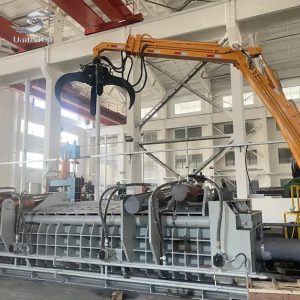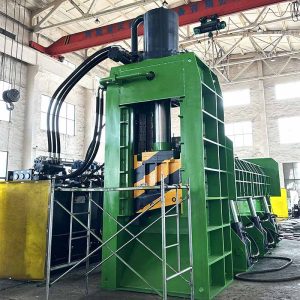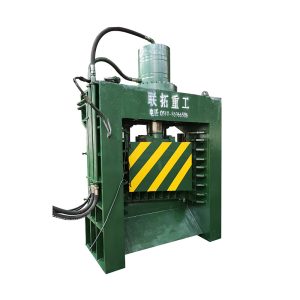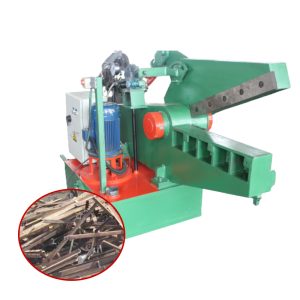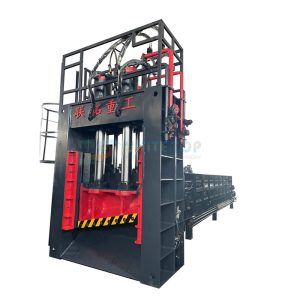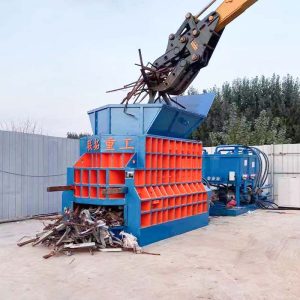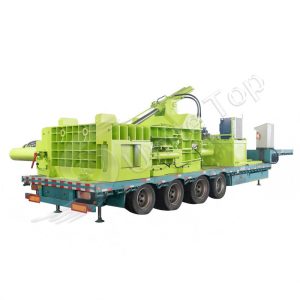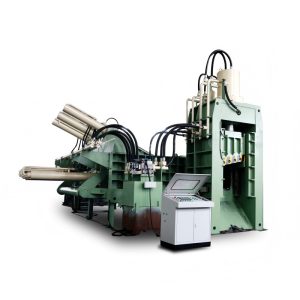Selecting the right metal baler is a decision that directly affects your operation’s efficiency, profitability, and environmental footprint. Whether you manage a recycling yard, a fabrication plant, or a demolition site, the correct baler can turn bulky scrap into compact, high-value bales while reducing transport and storage costs.
This guide offers a comprehensive overview to help you identify the ideal metal baler for your industry—covering machine types, technical features, purchasing considerations, and long-term maintenance strategies.
Understanding What a Metal Baler Does
A metal baler is an industrial machine designed to compress scrap metal into dense, uniform bales for easy handling, storage, and resale. Through hydraulic or mechanical pressure, balers reduce volume by up to 90 percent, allowing businesses to save space and transport costs while improving recycling efficiency.
In addition to cost savings, balers enhance workplace safety by keeping scrap organized and reducing manual handling. Many industries—from automotive dismantling to steel manufacturing—rely on balers as essential equipment in their material-management chain.
Main Types of Metal Balers
Not all balers are built alike. Understanding the main types will help you select one that aligns with your scrap profile, production scale, and facility layout.
Horizontal Balers
Horizontal balers compress material horizontally and eject the finished bale from the side. They are ideal for medium-to-large operations with continuous scrap flow. These machines can handle heavy and bulky metals, and are commonly integrated into automated conveyor systems.
Advantages:
- High throughput and continuous operation
- Compatible with automated feeding
- Suitable for heavy ferrous metals
Drawbacks:
- Larger footprint
- Higher installation cost
Vertical Balers
Vertical balers compress material from top to bottom, producing smaller bales ideal for lower scrap volumes. They are suitable for manufacturing plants, machine shops, or service centers that generate moderate quantities of metal waste.
Advantages:
- Compact and space-saving
- Lower capital cost
- Easy manual loading and operation
Drawbacks:
- Limited bale size and density
- Slower cycle times
Two-Ram Balers
Two-ram balers use one ram for compression and another for bale ejection. This allows for faster cycles and better compaction of springy or resistant metals such as stainless steel or aluminum.
Advantages:
- Consistent bale density
- Handles mixed materials
- Fast cycle times
Drawbacks:
- Higher complexity and maintenance cost
Shear Balers
Shear balers combine cutting and baling in one unit. They can shear long pieces—like rebar, pipe, or car frames—before compressing them into bales. These are essential for scrap yards handling oversized material.
Advantages:
- Cuts and compresses in one operation
- Reduces preprocessing needs
- Suited for large, irregular scrap
Drawbacks:
- Expensive and energy-intensive
- Requires trained operators
Portable or Mobile Balers
Mounted on skids or trailers, portable balers serve demolition sites or mobile recycling operations. They operate with diesel engines and are designed for durability in harsh environments.
Advantages:
- Mobility and flexibility
- No permanent foundation required
- Ideal for fieldwork or remote locations
Drawbacks:
- Lower throughput
- Higher fuel costs
Key Performance Specifications to Evaluate
Choosing a baler goes beyond its type. Technical specifications determine how efficiently it will perform under your unique conditions.
Compression Force
The compression force (measured in tons) defines how much pressure the baler can exert. Heavy steel scrap may require 300–1000 tons of force, while aluminum or light nonferrous metals need far less. Match force to your material’s density and resilience to avoid under- or over-specifying.
Cycle Time
Cycle time—how long it takes to compress, tie, and eject a bale—affects throughput. For high-volume operations, look for cycle times under 60 seconds. Consistent cycle speed ensures predictable daily output.
Bale Density and Size
Higher-density bales are easier to transport and yield better returns from smelters. However, bale size must align with your handling equipment and truck dimensions. Standard ferrous bales range from 600–1000 mm per side, while aluminum bales are typically smaller.
Feed Chamber Capacity
The charge box or feed chamber determines the maximum scrap size per load. If your scrap includes bulky pieces, ensure the chamber can accommodate them without pre-cutting.
Power and Energy Use
Balers can be powered electrically, hydraulically, or by diesel engines. Electric systems are clean and efficient for indoor installations, while diesel engines suit outdoor or mobile use. Review motor horsepower, hydraulic flow rate, and energy consumption to project operating costs.
Automation and Controls
Modern balers offer PLC control systems, automatic feeding, and remote monitoring. Automation improves safety, lowers labor costs, and decreases errors. For multi-shift operations, features like automatic tying or ejection improve productivity.
Build Quality and Materials
Look for a heavy-duty welded steel frame, wear-resistant liners, and corrosion-protected hydraulic components. The quality of seals, hoses, and valves directly affects reliability and maintenance intervals.
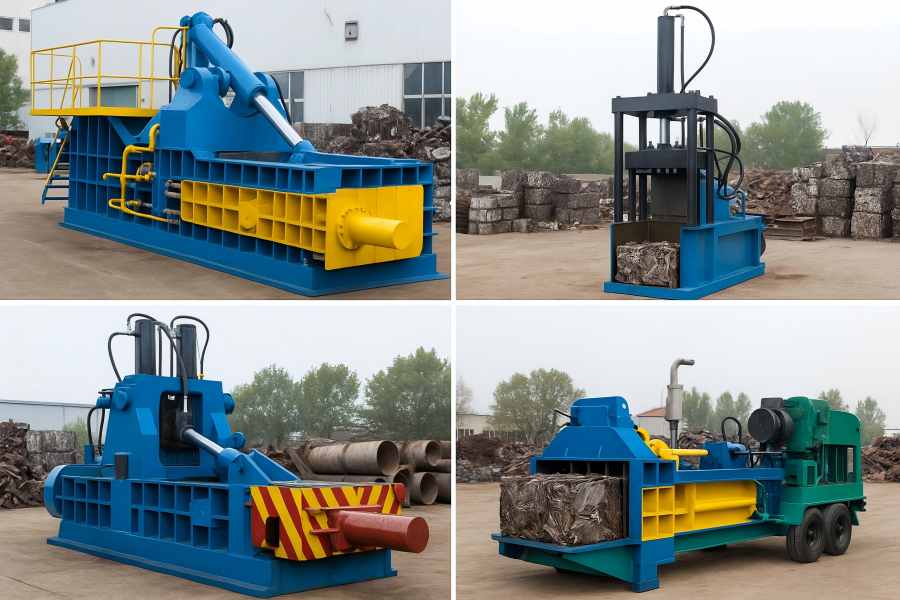
Matching a Metal Baler to Your Industry
Each industry has distinct scrap characteristics, space constraints, and operating models. Aligning your baler selection with these realities maximizes ROI.
Metal Recycling Yards
Scrap yards handle diverse, high-volume materials—from light aluminum to dense steel. Here, throughput, automation, and durability are key.
Recommended features:
- Heavy-duty three-ram or shear baler
- Automatic bale ejection
- Oversized feed box for irregular scrap
- High compression force (500 tons or more)
- Optional crane or conveyor integration
Manufacturing and Fabrication Plants
Fabrication shops generate steady volumes of uniform scrap, such as offcuts, punchings, and trimmings. Space and workflow integration often matter more than raw power.
Recommended features:
- Compact horizontal or vertical baler
- Electric power with low noise levels
- Hopper or conveyor feed from production lines
- Moderate compression force (100–300 tons)
Automotive Dismantling and Recycling
Vehicle recyclers must process car bodies, frames, and mixed materials. The right baler should manage varying thickness and shapes while maintaining speed.
Recommended features:
- Shear-baler combination
- High force and reinforced structure
- Optional pre-shredding or cutting system
- Mobile units for on-site operations
Nonferrous Metal Processors
Operations handling aluminum, copper, or brass focus on purity and gentle compaction. Bale uniformity and contamination control take precedence.
Recommended features:
- Two-ram or continuous-feed baler
- Moderate force and adjustable pressure settings
- Automated tying system for consistent bale dimensions
Demolition and Construction Contractors
Field operations require mobility, ruggedness, and minimal infrastructure. Portable balers provide an all-in-one solution for handling metal on site.
Recommended features:
- Diesel-powered portable baler
- Shearing capability for beams and rebar
- Fast setup and teardown design
Space, Layout, and Power Planning
Even the best baler underperforms if installed poorly. Before purchasing, assess:
- Floor space and clearance: Horizontal balers need a long footprint, while vertical units save area but require higher ceilings.
- Foundation strength: Heavy units demand reinforced concrete pads to absorb vibration and support load.
- Material flow: Design a logical workflow from scrap generation to baler loading, bale storage, and truck access.
- Power supply: Verify voltage, amperage, and phase compatibility. Allow a 20 percent safety margin for startup loads.
- Ventilation and noise control: Especially for indoor operations, plan for exhaust, temperature control, and sound insulation.
Comparing Brands and Models
With numerous manufacturers competing globally, comparing models based solely on brochure data can be misleading. Use these evaluation criteria:
- Performance validation: Request test results or live demonstrations of bale density and cycle speed.
- Component sourcing: Ensure pumps, cylinders, and control units are from reputable brands.
- Ease of maintenance: Check accessibility of hydraulic lines and replaceable wear plates.
- Operator interface: Favor intuitive touchscreens or remote controls with diagnostic functions.
- Service network: Local support drastically reduces downtime.
- Warranty and uptime guarantees: Confirm coverage on hydraulics, structure, and electronics.
Think at the entire cost of ownership when comparing bids, not just the purchase price. A slightly costlier baler with lower energy use and better reliability may pay for itself within two years.
Estimating Total Cost of Ownership (TCO)
The financial equation consists of more than just the buying price. Factor in:
| Cost Element | Typical Share of Lifetime Cost | Description |
| Capital Cost | 40–50 % | Machine purchase, delivery, installation |
| Energy Use | 15–20 % | Electricity or diesel fuel during operation |
| Maintenance | 10–15 % | Spare parts, hydraulic oil, wear plates |
| Labor | 10–20 % | Operators, maintenance staff, supervision |
| Downtime | 5–10 % | Lost production during failures or service |
Calculate your expected payback period by comparing cost savings from reduced transport, increased scrap value, and improved logistics against total investment.
The Role of Automation and Safety
Automation transforms productivity and safety in modern baling operations. Consider investing in:
- Auto-feed systems that synchronize conveyors or cranes with the baler cycle
- Auto-tie mechanisms to standardize bale dimensions and reduce manual labor
- Remote monitoring for performance data and preventive maintenance alerts
- Safety interlocks on access doors to prevent hydraulic activation during loading
- Emergency stop systems positioned around the machine
- Guarded moving parts and lockout-tagout procedures
Safety should never be an afterthought. Compliance with ISO, CE, or OSHA standards ensures operator protection and may reduce insurance costs.
Installation and Commissioning
The foundation for years of dependable service is laid by a competent installation. The process typically includes:
- Site preparation: Concrete pad curing, anchoring points, drainage setup
- Electrical connection: Wiring and circuit protection according to manufacturer guidelines
- Hydraulic system setup: Reservoir filling, leak testing, and pressure calibration
- Trial runs: Dry operation followed by load testing
- Operator training: Hands-on instruction for safety, control logic, and maintenance
Document every step in an installation checklist to simplify future inspections or warranty claims.
Maintenance and Service Strategy
Routine maintenance extends the lifespan of your investment. Follow a structured schedule:
Daily:
- Check hydraulic fluid level and temperature
- Inspect hoses and seals for leaks
- Clean debris from feed chamber and sensors
Weekly:
- Lubricate moving parts
- Verify pressure settings and safety interlocks
- Inspect bale-ejecting mechanism
Monthly:
- Replace hydraulic filters
- Tighten bolts and fittings
- Calibrate control system sensors
Annually:
- Replace worn liners and seals
- Flush and refill hydraulic oil
- Perform structural integrity inspection
Keep detailed maintenance logs, including service intervals, parts replaced, and downtime incidents. Data trends can help forecast component wear and schedule preventive maintenance.
Buying New vs. Used Metal Balers
Buying new ensures warranty coverage and the latest efficiency improvements, but high upfront cost may deter smaller operations. Used balers, when properly inspected, can offer excellent value.
Advantages of buying new:
- Latest technology and automation
- Custom configuration options
- Full manufacturer warranty
- Lower maintenance risk
Advantages of buying used:
- Lower initial investment
- Shorter delivery time
- Proven performance if inspected properly
If buying used, perform a full inspection of the hydraulic system, frame, and control units. Request maintenance records, check operating hours, and run a live test under load. Avoid units showing excessive frame fatigue or oil leakage.
Vendor and After-Sales Support
A trustworthy supplier can be as valuable as the machine itself. Prioritize companies that provide:
- Local service technicians and stocked spare parts
- Remote troubleshooting capability
- Operator and maintenance training programs
- Fast response for breakdowns
- Clear communication and documentation
Some manufacturers offer service contracts guaranteeing uptime or fixed-cost maintenance—an attractive option for busy facilities.
Environmental and Regulatory Factors
Modern industries face increasing scrutiny over environmental impact. Choosing an eco-friendly baler can support compliance and sustainability goals.
- Hydraulic fluid containment: Use double-walled reservoirs and spill trays.
- Energy efficiency: Variable-speed pumps and regenerative hydraulic systems reduce power consumption.
- Noise control: Acoustic enclosures or dampers protect operators and meet urban noise limits.
- Emissions: Diesel units should meet local emission standards or include filtration systems.
- Recyclability: Machines built from recyclable steel and modular components simplify end-of-life disposal.
Financing and Procurement Tips
For capital-intensive equipment like balers, smart financing can preserve cash flow.
- Leasing: Pay monthly installments and upgrade later without full ownership burden.
- Equipment loans: Fixed-rate loans spread payments over several years.
- Government subsidies: Some regions offer grants or tax credits for recycling equipment.
- Bulk procurement: If you operate multiple facilities, negotiate multi-unit discounts or shared service contracts.
Always review total finance costs, including interest, maintenance, and insurance.
Future-Proofing Your Investment
A baler is a 10- to 15-year asset. Future-proofing means anticipating changes in material flow, labor availability, and technology.
- Choose modular systems that can scale up with production.
- Ensure software and controls can integrate with future plant automation.
- Prefer brands with long-term spare-part commitments.
- Consider hybrid or electric models as sustainability standards evolve.


